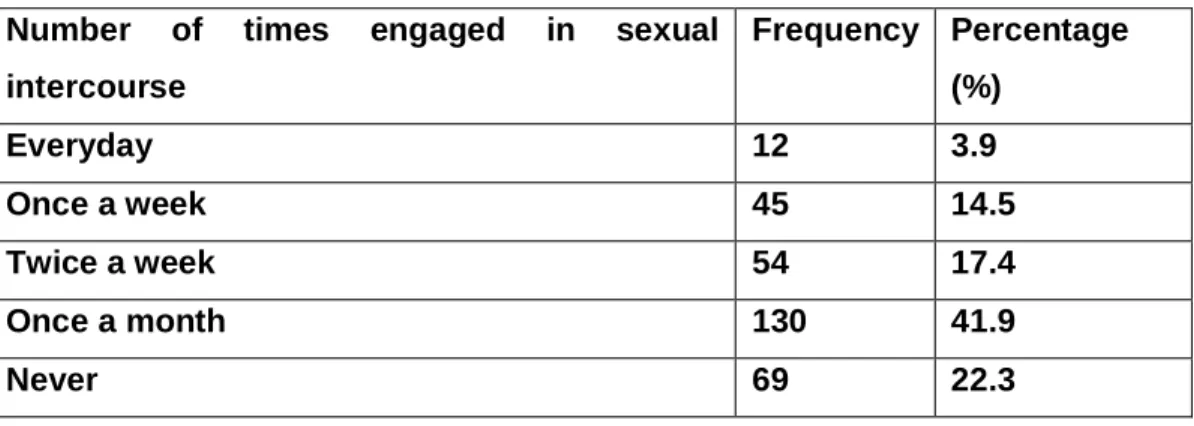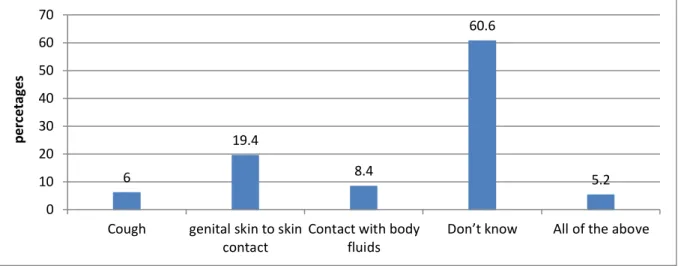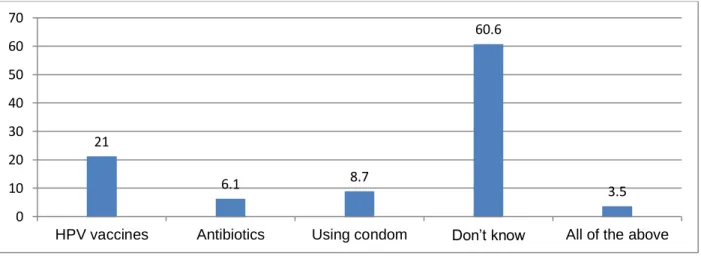Purpose: The purpose of the research was to determine the knowledge of female students about HPV and vaccines at a selected university in Limpopo Province, South Africa. Methodology: To determine the knowledge of female students about HPV and vaccines, we used a quantitative approach using a cross-sectional descriptive design.
INTRODUCTION
BACKGROUND OF THE STUDY
More than half of the students knew that HPV is sexually transmitted and that HPV vaccines are preventive. A pooled assessment in the same study found that more than three-quarters of students did not know much about HPV vaccines, and half of students had little information about HPV.
PROBLEM STATEMENT
Less than half of the students knew that the vaccine was provided free of charge by the government in South Africa (Mofolo et al., 2018). Furthermore, it will also help the government to spend its budget in other areas, such as improving the health service rather than treating HPV-related diseases such as cervical cancer (Grandahl et al., 2018.
RATIONALE OF THE STUDY
SIGNIFICANCE OF THE STUDY
PURPOSE OF THE STUDY
OBJECTIVES OF THE STUDY
THEORETICAL FRAMEWORK
This is the person's belief about the effectiveness of the recommended measure to reduce the risk of being affected by the disease. These are the person's beliefs and the costs of the recommended behavior that may affect them psychologically.
DEFINITION OF CONCEPTS
The health model was used as a theoretical framework for the study because of its focus on individual perceptions of illness and their beliefs about actions to prevent the illness and how their behavior affects their health. The model assumes that female students are more likely to engage in the health-promoting behavior if they believe they are more susceptible to disease and the disease is more severe.
CHAPTER OUTLINE
In this study, knowledge would mean facts, information that female students have about HPV prevention. In this study, the HPV vaccine would mean the substance (Gardasil and Cervarix) that provides immunity against the human papillomavirus.
CONCLUSION
LITERATURE REVIEW
BIOLOGICAL HISTORY OF THE HUMAN PAPILLOMA VIRUS
RISK FACTORS OF THE HUMAN PAPILLOMA VIRUS
PREVENTION OF THE HUMAN PAPILLOMA VIRUS
KNOWLEDGE REGARDING THE HUMAN PAPILLOMA VIRUS PREVENTION
RISKY SEXUAL BEHAVIOR OF FEMALE STUDENTS
HPV PREVENTION PROGRAMMES IN SOUTH AFRICA
SUMMARY
INTRODUCTION
STUDY APPROACH
STUDY DESIGN
STUDY SETTING
STUDY POPULATION
SAMPLING
- Criteria for inclusion
- Sampling size
- Sampling technique
DATA COLLECTION INSTRUMENT
VALIDITY AND RELIABILITY OF MEASURING INSTRUMENT
- Validity
- Face validity
- Content validity
- Reliability
PRE-TEST
PROCEDURE FOR DATA COLLECTION
MANAGEMENT OF DATA AND ANALYSIS OF DATA
ETHICAL CONSIDERATION
- Permission to conduct a study
- Informed consent
- Voluntary participation
- Confidentiality and Privacy
- Protection of participants from any harm
DISSERMINATION OF THE RESULTS
CONCLUSION
PRESENTATION OF THE RESULTS
DEMOGRAPHIC DATA OF THE RESPONDENTS
A descriptive analysis was performed to find the frequency distribution and percentages of demographics such as gender, age, school/faculty name, level of education, and marital status. The results of the survey showed that the majority of the respondents were female and that 2 (0.6%) of the respondents were gay. The majority 93 (30%) of the respondents were from the School/Faculty of Management Sciences and 20 (6.5%) from the School of Agricultural Sciences.
In addition, the results of the survey also revealed that of the respondents were attending the 3rd level of their studies and were honors/4th year students. Regarding the marital status of the respondents, the majority of respondents were single, while 8 (2.6%) lived together.
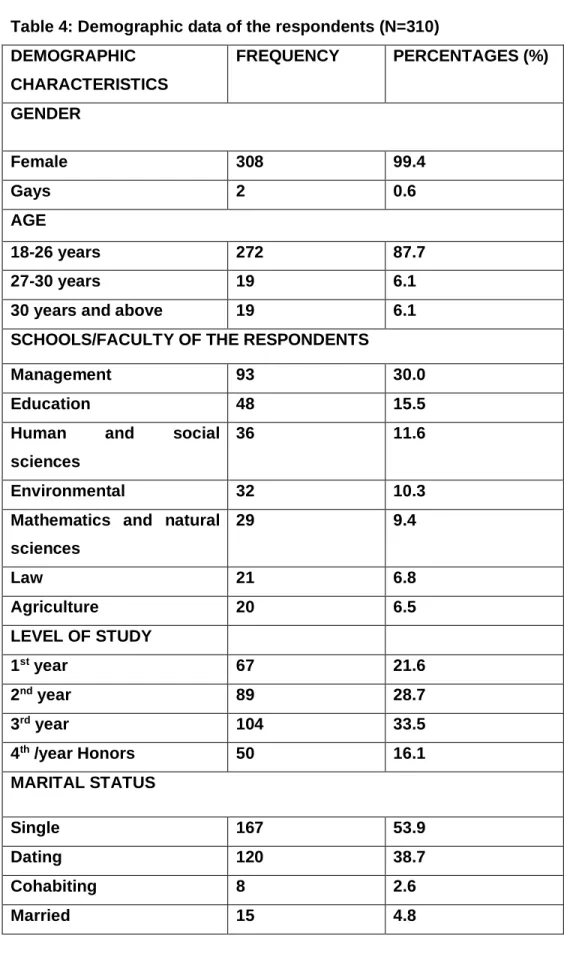
SEXUAL HISTORY OF THE RESPONDENTS
- Sexual activity
- Sexual partners in the last 3 years
- Contraceptive methods
- Circumstances of using a condom
- Diagnosed with sexual transmitted infections
The results showed that of the respondents use a condom as a contraceptive method, while 8 (2.6%) of the respondents use an IUCD/LOOP as a contraceptive method. The results showed that the subjects always use a condom during sexual intercourse, while the respondents use a condom occasionally. The results showed that the majority of respondents had never been diagnosed with an STI, while they had only been diagnosed with an STI.
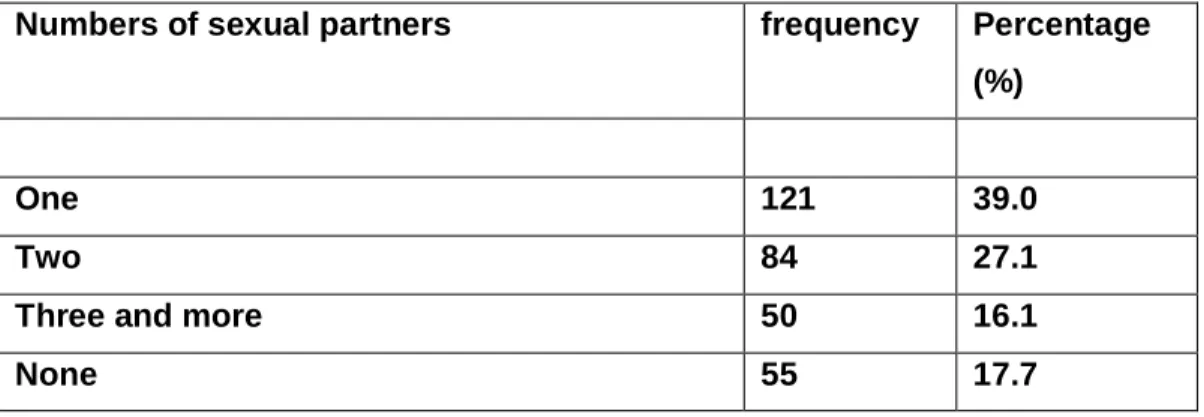
KNOWLEDGE REGARDING THE HUMAN PAPILLOMA VIRUS…
- Information about the human papilloma virus
- Source of information about the human papilloma virus…
- Health problems related to the human papilloma virus
- Medium at which the human papilloma virus is transmitted
- Prevention of the human papilloma virus
- Gender mostly affected by human papilloma virus
The results showed that the respondents have never heard about HPV from anywhere, while only 30 (9.7%) of the respondents heard about HPV from health care workers. The results of the study showed that the respondents do not know any health problems related to HPV and the respondents know that cervical cancer is one of the health problems related to HPV. The results of this study further showed that 24 (7.7%) of the respondents know that cervical cancer, anal cancer and genital warts are HPV-related health problems, while 20 (6.5%) of the respondents recognize genital warts as health. HPV-related problem and few respondents 6 (1.9%) know that anal cancer is an HPV-related health problem.
Most of the respondents indicated that they do not know the medium through which HPV is transmitted, indicated that HPV is transmitted through genital skin to skin, indicated that contact with body fluids can transmit HPV from one person to another, while 2 (6 % ) of the respondents indicated that HPV can also be transmitted through coughing and only 16 (5.2%) of the respondents indicated that the genital skin. Most respondents indicated that they do not know about HPV prevention, indicated that they know that HPV vaccines can prevent HPV, indicated that they know that using a condom during intercourse can protect them from infection by HPV infections. , while 19 (6.1%) of the respondents indicated that they knew that antibiotics can prevent HPV infections and only 11 (3.5%) indicated that HPV vaccines, antibiotics and the use of condoms during sexual intercourse can prevent HPV infections. The results of the study showed that of the respondents that women are the ones most affected by HPV, they indicated that they do not know which gender is more affected by HPV, while they indicated that both sexes are affected by HPV and only 3 ( 1.0%) of respondents indicated that HPV can also affect men.
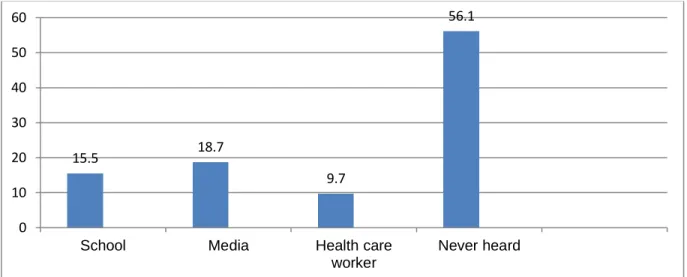
KNOWLEDGE REGARDING THE HUMAN PAPILLOMA VIRUS VACCINE…
- Two human papilloma virus vaccines are available in South Arica
- Human papilloma virus vaccines are available to girls at primary level
- Human papilloma virus vaccines are given to girls before they are sexual active…37
- Human papilloma virus vaccines prevent cervical cancer
- Human papilloma virus vaccines prevent HPV and STIs…
- Human papilloma virus vaccines are not effective on the HPV infected person
- Human papilloma virus vaccines should be given at 6 months interval
- Knowledge regarding the HPV vaccines that are available in SA
The results of the survey showed that of the respondents who were unsure about the HPV vaccines available for girls at the primary level, disagreed that the HPV vaccines are available for girls at the primary level, while of the respondents agreed that HPV- the vaccines are available to girls at primary level. The results of the survey showed that of the respondents who do not know whether the HPV vaccines prevent cervical cancer or not, they agreed that the HPV vaccines prevent cervical cancer, and 19 (6.1%) disagreed that the HPV vaccines prevent cervical cancer. The results showed that of those surveyed who were unsure whether the HPV vaccines prevent HPV and STIs agreed that the HPV vaccines prevent HPV and STIs and disagreed that the HPV vaccines prevent HPV and STIs .
The results indicated that some of the respondents were unsure whether HPV vaccines are effective for HPV infected person or disagreed that HPV vaccines are not effective for HPV infected persons and agreed that HPV vaccines are not effective for HPV -infected persons do not. The results revealed that the majority of respondents were unsure whether HPV vaccines should be given at 6-month intervals or not, agreed that HPV vaccines should be given at 6-month intervals and few 27 (8.7%) of the respondents did not agree that HPV vaccines should be given at 6 month intervals. The results revealed that the majority of respondents were unsure whether Gardasil and Cervarix are the HPV vaccines available in South Africa, agreed that Gardasil and Cervarix are the vaccines available in South Africa and only 19 (6.1%) disagreed that Gardasil and Cervarix are the HPV. vaccines available in South Africa.

CONCLUSION
DISCUSSION OF THE RESULTS
DEMOGRAPHIC DATA OF THE RESPONDENTS
SEXUAL HISTORY OF THE RESPONDENTS…
KNOWLEDGE REGARDING THE HUMAN PAPILLOMA VIRUS
The study showed a positive correlation between the level of the study and knowledge about HPV (P=0.003). The results of the survey showed that the majority of respondents were unsure about the HPV vaccines available in South Africa. The study indicated a significant association between knowledge of the HPV vaccines and faculty or school (P=0.001).
Knowledge regarding the HPV and the HPV vaccine at a selected university was associated with marital status and faculty or school. The results of the study indicated that there is a significant relationship between knowledge regarding the HPV vaccine and the school or faculty of the respondents. The respondents from the School of Management Sciences showed a better understanding of the HPV and vaccine compared to other schools.
The study concludes that the female students at the selected university have no knowledge related to HPV and vaccines, for example, the majority of students have never heard of HPV and. The results of the study indicated that many students at the selected university have no knowledge about HPV and vaccines. There is a need for information about HPV and vaccines through various means of communication.
KNOWLEDGE REGARDING THE HUMAN PAPILLOMA VIRUS VACCINES…
CONCLUSION
INTRODUCTION
SUMMARY
CONCLUSION
Respondents also lack knowledge about the HPV vaccines, the majority of them did not know what types of vaccines are available in South Africa, who should receive the vaccines, at what age the vaccines are given and until what age the vaccines are administered. datum. Respondents did not know what the HPV vaccine prevents and how the vaccines should be administered.
RECOMMENDATION
Help-seeking intentions among Asian American and White American students in psychological distress: Application of the health belief model. Knowledge of cervical cancer, human papillomavirus and prevention among first-year female students in residences at the University of the Free State. Knowledge of Saudi female university students regarding cervical cancer and acceptance of the human papillomavirus.
Title of the research study: Female students' knowledge of human papillomavirus (HPV) and the vaccine at a selected university in Limpopo Province, South Africa. Brief introduction and purpose of the research: Human papillomavirus (HPV) is a sexually transmitted virus, spread by genital contact. The purpose of the research is to determine the knowledge of female students about the human papillomavirus and the HPV vaccine at a selected university in Limpopo province, South Africa.
Summary of procedures: the study population will include female students residing in the residences of the University of Venda. Study costs: Participants will not be expected to cover any study costs. In view of the research requirements, I agree that the data collected during this study may be processed in a computerized system by the researcher.

